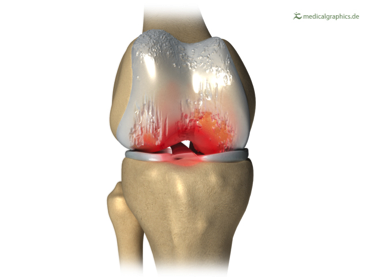
Anterior view demonstrating osteoarthritis (Degenerative Joint Disease) of the right knee joint.
Conventional wisdom said that osteoarthritis (OA; degenerative joint disease – DJD) of the knee is an outcome of from wear and tear, which is why it’s more common among older people and those whose excess body weight puts extra stress on those joints. Therefore the expectation was that people in the past, especially early hunter-gatherers and early farmers, would have had a much higher prevalence of osteoarthritis than people do today. It was hypothesized that all the activities from running and hunting in the days before cars and couches would have worn out joints quickly.
To prove this hypothesis, Ian Wallace, a researcher from Harvard, flew around the US and studied human skeletons that had ended up in museums or had been donated to medical schools for scientific research. The skeletons were from people who died as long ago as 4,000 B.C. The oldest specimens that were looked at were some skeletons from prehistoric Inuit hunter-gatherers from Alaska. The most recent ones were the remains of people who died in Tennessee in 2015.
The study published in Proceedings of the National Academy of Sciences shows that even correcting for body mass index and age, osteoarthritis of the knee is twice as common now as it was before the 1950s. So there’s apparently something else driving the increase in knee arthritis. However the current study doesn’t pinpoint that cause.
This makes sense to Dr. Richard Loeser a rheumatologist who directs the Thurston Arthritis Research Center at the University of North Carolina, Chapel Hill. “Your joints aren’t just like your automobile tires that wear out as you use them,” he says. In fact, exercise helps nutrients diffuse into cartilage in the knee and keep it strong and healthy. If cartilage “is formed and more healthy when you’re younger, then your joints are more likely to be functioning better and have less osteoarthritis when you get older,” Loeser says. And exercise also helps fully grown people. By strengthening your muscles and by stimulating your cartilage you can still improve the health of your joint. That’s not to say that exercise fully explains the trend that the Harvard researchers have noted.
(News From NPR.)
This blog post article was reproduced with permission from Terra Rosa
www.terrarosa.com.au
(Note: Click here for an article on osteoarthritis of the cervical spine.)


